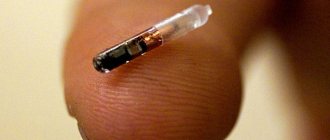Microchipping of cats is a procedure that all pets undergo in European countries. In our country, the attitude towards it is ambiguous. To most cat owners who have a vague idea of the purpose of this procedure, it seems strange and completely unnecessary. But if you are planning to move to another country or are going to travel with your four-legged pet, you cannot do without a chip.
Why do you need microchipping? What are its advantages and disadvantages? How does this procedure work and what does it give to the cat and its owner? You will find answers to these and many other questions in our article.
The essence of the procedure
What is cat microchipping? This is the electronic identification of cats or any other animals. The essence of this procedure is that a miniature microcircuit, or chip, with a unique fifteen-digit digital code is inserted under the animal’s skin, containing all the information that the cat’s owner considers necessary to provide - name, gender, breed, date of birth, special features, information about vaccinations, past illnesses, often - a photo of the pet, as well as information about its owner - name and exact address (telephone, website and other data are optional).
Immediately upon completion of the chip implantation procedure, the animal owner receives a registration certificate, which contains full information about the manipulation performed, and a note is placed in the international veterinary passport of the cat, certified by the seal of the institution in which it was carried out and the signature of the veterinarian who performed it.
Features of chipping in Russia
No matter how simple and painless the manipulation of implanting a chip under the skin is, there are some contraindications.
Animals that are sick cannot be microchipped.
Of course, the animal’s immune system is already working hard, trying to cope with pathogens. Even though the microcircuit is surrounded by glass that is not rejected by the body, it is not worth the risk. Nobody needs inflammation.
You cannot administer 2 chips to one pet.
Inside the chip there are no batteries, wires or complex “bells and whistles” that can disable this little “identifier”. Therefore, the chip cannot break! Simply put, there is nothing to fail there. Before inserting a chip, the veterinarian must ensure that the cat or dog has not previously been microchipped.
Little is required from owners: make sure that the pet does not scratch the injection site. And you can’t get it wet, otherwise inflammation may develop.
Where and how can this operation be performed?
Now we’ll talk about where and how this operation can be performed. Microchipping of cats and dogs (as well as other animals) is carried out by veterinarians in clinics. You should not trust any dubious organizations that do not have quality certificates or relevant documents for the chip. Don't risk your pet's health.
Find out in advance whether the clinic you choose can perform microchipping. Read reviews about the staff working there. In particular, in St. Petersburg we recommend this clinic https://zoochempion.ru/chipirovanie-sobak-i-koshek/. You can find out even more information on the clinic's website.
Why do they do this?
The main purpose of microchipping a cat is to mark the animal by introducing a microchip under the skin with an identification number and complete information about the cat and its owner. What is it for? First of all, in order to prevent the theft of an animal, and if it is lost, to quickly find and return it to the owner.
From films, fiction and history textbooks, we know that the problem of designating their rights to this or that living creature has faced people since ancient times. And if the value of a dog or cat was very doubtful, then a sheep, goat or cow was unconditional. If a person’s cow was taken away, and a couple of days later exactly the same one suddenly appeared at the other end of the village, how could the owner prove that it belonged to him? Of course, sometimes the animal itself could recognize the owner, but such cases were very rare.
In the old days, this problem was dealt with by branding with a hot iron. This cruel, extremely painful and completely inhumane procedure was subjected to all animals in the herd, in countries where the slave system flourished, along with cows and sheep, draft animals of a different kind - unfortunate slaves. Not to mention the ethical side of this monstrous manipulation, it could hardly be called reliable: the stigma was not too difficult to fake or even remove. In addition, this method of tagging was absolutely not suitable for small animals with thin skin - dogs, cats, monkeys.
A tattoo has proven to be an equally unreliable way to protect your property from attacks. It could have been even easier to fake it. In addition, it is not easy to see: the thick fur of the pets reliably hid the tattoo even from the eyes of the owner himself.
Only in the second half of the last century, with the advent of the first microcircuits, did the dream of many pet owners come true - to effectively identify their pets. First of all, farmers appreciated the new invention: thanks to the chips, their dawns and cows were now reliably protected from robbers. The time has come for small pets to be microchipped.
Of course, it is not advisable to implant a chip under the skin of all cats - at least in the territory of the former Soviet Union. It is unlikely that, seeing an ownerless and clearly feral tabby cat on the street of a provincial town, anyone will suspect that it has a chip and will immediately rush to catch it and take it to a veterinary hospital for identification. And not every institution of this kind has a scanner for reading information. It’s another matter when an expensive purebred cat is lost. If it ends up in a rural area, the likelihood of its identification is low, but in a large city it has a much better chance of finding its owner.
The microchipping procedure for domestic dogs of the “noble” breed is not mandatory. Only occasionally do loving owners turn to a veterinary clinic about implanting a chip under the skin of their outbred beauty. However, in some cases this procedure is necessary:
- for a cat to participate in an exhibition of a felinological club;
- so that the animal can be taken abroad without hindrance.
In some states, a cat is required to have a chip even for domestic transportation. This is dictated by reasons of sanitary safety, since cats, like other mammals, are carriers of the rabies virus and must be vaccinated.
If a cat takes part in international exhibitions, its accurate identification is necessary to assign a champion title, admission to breeding and determine the value of the litter. In addition, this measure will help protect a purebred cat from being replaced or stolen (which occasionally happens at exhibitions), since at the first visit to the veterinary clinic the missing cat will be immediately discovered and the criminal will be exposed.
Benefits of chipping
Well, after we have already learned about what chipping is, when and by whom and why it was invented, it’s time to take a closer look at the advantages of this procedure. So:
- If your cat gets lost, it will be easier for you to find it, because if it ends up in a shelter or foster care and they see that it has a microchip, all you need to do is scan it, and information about you, as the cat’s owner, will already be available. known. And, there will be only a few hours left before meeting your “lost one”.
- The presence of a microchip, and your knowledge that your cat has it, moreover, documentary confirmation of its number (using a special plastic card) are all additional arguments in favor of the fact that you are the rightful owner of the cat. Do you think that no one will ever dispute this fact? Unfortunately, various situations happen in life, and sometimes an expensive cat breed is an excuse to cash in on it. Fraudsters can trick you into giving you an animal or even steal it, and then claim that the cat is not yours, but theirs. In order to dispel the judge's last doubts in this dispute, you will simply need to give the chip number and show the relevant documents.
- If your cat has a microchip, its service at the veterinary clinic will be much faster, since the accounting system will be simplified as much as possible, thanks to the fact that instead of filling out stacks of papers about your pet and collecting archival records, it will be enough to simply scan the microchip data. The same can be said about accounting in the felinological structure - it will also become much simpler, faster and more convenient for you and your animal.
- The presence of a microchip is a guarantee that no one will ever replace your dear and beloved cat. It will be enough to simply scan its microchip, and everything will become clear - your animal is in front of you or someone is trying to pass off another cat as yours.
Detailed description of the process
Would you like to have your pet microchipped, but are you afraid that he will be hurt during the manipulation, and then all his life the poor thing will feel discomfort from the presence of a foreign body in the body? Completely in vain! This procedure is completely safe and virtually painless, and after it microchipped cats do not experience any discomfort.
What does the chip look like? Photo
The identification chip implanted under the skin of an animal is very small in size. The capsule in which it is placed is about one centimeter in length and no more than two millimeters in width. This is the size of one oblong grain of rice. It is made of ceramics or high-tech glass. The presence of these materials in the body of any living creature, be it an animal or a human, is absolutely safe, since they are hypoallergenic and do not cause a negative reaction from the immune system. The body simply does not “notice” them.
Security and order
Both branding and microchipping were developed to help identify pets. The uniqueness of a brand is no less than the uniqueness of a radio tag, but it is still easier to fake a brand. This means it’s easier to pass off one animal as another. For example, at an exhibition or border.
OUTDATED METHODS . There was a practice of using tags and labels. Not only was their installation accompanied by pain, but wearing them was also dangerous.
How does a stamp “work”?
The mark is a tattoo. It can be applied with a pen to the groin fold or with forceps to the ear. The procedure is short, but still painful, and the durability of the stigma is low. As the animal grows, the pattern becomes very blurred. Often you have to repeat the procedure at an older age.
At the same time, the mark is unique. It usually consists of two parts:
- code - identifier of the breeder, club or nursery;
- serial number - assigned to each born kitten.
Each brand number is entered into the stud book, which is mandatory for all breeders and official clubs. Each kitten is taken into account: its name, parents, date of birth, gender, color, owner’s details are entered into the database.
If suddenly the animal is lost, then the number and code of the brand must be reported to all organizations in which this animal may appear with a new owner (veterinary clinics, clubs, nurseries). Most often, it is veterinarians who discover long-standing losses.
ADVICE! To any method of permanent identification (tags, electronic tags, brand) it is better to add the most ordinary medallion-addresser on the collar.
Why is the chip more reliable?
Microchipping is gaining popularity and is coming to the most remote corners of the country. However, these unique markings are mostly on show animals, whose safety is a high priority. RFID as a means of identification has a number of advantages over branding:
- it is extremely difficult to fake a chip and reproduce all the information in the database;
- international registration of the code allows you to serve the animal anywhere in the world;
- unambiguous reading without errors anywhere at any time and regardless of language;
- good preservation and high reliability.
It’s even better to combine two types of identification. Since the brand remains a priority for Russian breeders, every purebred animal must have one. But with a chip you can additionally protect your pet from theft or loss. If an attacker sees the mark and tries to remove it, the chip will not be able to be detected without a special device.
DID YOU KNOW?
Pets are legally the property of a citizen. In case of theft, the police are obliged to search for the animal itself and the intruders who stole it.
Beware of scammers
It may happen that the animal is stolen. The goal is usually simple - to get offspring and sell them at a higher price. But what makes kittens and puppies expensive is not branding and microchipping, but official mating, pedigree and exhibition merits, about which the scammers know nothing.
Something else interesting: How to make a cat scratching post
No pet lovers club will accept an unknown cat or dog without documents into the breeding program. Therefore, the presence of a chip or brand will not help criminals get expensive offspring from your pet.
Never give anyone the original pedigree (except for exchange for an international sample), diplomas and certificates of your pet. Never give copies of your personal documents to strangers: they can be used to transfer ownership of an animal to another person.
Your general passport must be attached only to the application for a change of owner and to the mating certificate. In both cases, you do this voluntarily and subject to certain conditions of the contract.
Implantation rules
We hasten to reassure those who are afraid to microchip their pet for fear of causing him unbearable pain. The procedure that the animal will undergo lasts no longer than a regular routine vaccination and is just as painless.
The capsule containing the microchip is injected into the animal's space under the skin between the shoulder blades. For this purpose, a special disposable sterile applicator is used, which looks very similar to a regular syringe.
The procedure for introducing a microchip is also similar to a regular injection. The veterinarian wipes the skin on the animal’s withers with alcohol, gathers it into a fold, and then the applicator needle with a microchip is inserted into the cat at an angle of 30 degrees. With his thumb, he presses the applicator plunger all the way. A clicking sound means the microchip is embedded under the skin. After this, the needle is removed and the whole and unharmed cat is handed over to the terrified owner.
The microchip is designed to last for 25 years. Cats very rarely live longer, so re-chipping is usually not necessary.
A standard chipping kit, in addition to an applicator and a capsule with a microcircuit, contains a plastic card on which the full information from the chip is duplicated, and a special sticker for a veterinary passport, on which an individual chip number is applied. The latter, together with the date of microchipping, the signature of the veterinarian and the seal of the clinic, is necessary to confirm the procedure performed.
By attaching a sticker to the passport, entering the date of microchipping and stamping it, the doctor registers your pet in a unified database. From now on, you can travel with your cat around the world without experiencing any difficulties crossing borders.
And one more important point: the optimal age for chipping. As a rule, this procedure is performed on babies aged two months, at the same time as the first vaccination. However, if you have received an adult cat or you are about to move abroad and you do not intend to part with your beloved pet, you can microchip it at any age.
Microchipping of dogs
Microchipping dogs is a simple procedure, absolutely painless, and does not cause any complications in the animal.
The process is:
- The veterinarian takes the package with the chip. Be sure to compare what is written on the packaging and what appears on the device’s display when scanning the chip itself. These 15 digits must match exactly.
- The chip must be sterilized. Since the chip is protected by glass, there is no need to worry that an important part will be damaged by alcohol or other disinfectant.
- Next, the veterinarian inserts the chip under the skin using a syringe. One injection site! This is in the area of the withers or shoulder blades. Not in the thigh, not in the neck! After implantation, the place where the contents of the syringe were injected must be scanned. If everything was correct, the numbers will immediately appear on the scanner display.
- Next, the veterinarian fills out special documents and enters you into a single database. A note is made in the animal's passport and a unique identification code is recorded.
How is the reading done?
You can read data from the chip immediately after it is implanted. To do this, they use a special scanner - a device that generates weak electromagnetic pulses, with the help of which the chip is “charged” for a short period of time and, in turn, begins to emit signals. They are perceived by a special reading device built into the scanner.
All this is completely safe for the animal, since the power of electromagnetic waves cannot harm the animal. Until the scanner is brought closer to the chip, it will not work.
It should be noted that information can be read from the chip almost an unlimited number of times, since the microcircuit cannot be demagnetized or discharged; all information is stored at the molecular level.
Before introducing a capsule with a microchip, the veterinarian must check that the new device is working. After the manipulation, a check is also necessary - this time in order to find out whether the chip was damaged during the implantation process.
Misconceptions and facts
Many owners are convinced that the microchip has the function of a GPS tracker, and they will be able to track the location of the dog using a satellite. This is an absolute fallacy. The chip doesn't work that way. Moreover, without a scanner it is even impossible to determine whether it is there or not. What then is its meaning and is there a chance to find the missing animal?
The effectiveness of chipping has been proven by many years of experience of various organizations in developed European countries. A huge, multi-stage system, including clinics, shelters, nurseries, catching services, all checkpoints and an international database, sometimes allows an animal to be identified and returned to its owner in a matter of hours.
Pros and cons of microchipping cats
Discussions about the advantages and disadvantages of microchipping are meaningless if your pet is a cat of an elite breed, takes part in international exhibitions and is the father of future champions. In this case, it must be microchipped. It's a different matter when it comes to the safety of a mongrel, but very beautiful cat, which can also be stolen - if not for sale, then for oneself. If you want to protect your pet from the attacks of dishonest people, before subjecting it to microchipping, weigh the pros and cons. We hope what you read below will help you make the right decision.
About the advantages
The undeniable advantages of having a microchip in a pet include:
- increasing the chances of the cat’s safe return in the event of his disappearance (we all know how curious and restless our tailed pets are and how often they strive to slip through the door crack to go in search of adventure);
- the ability to prove in court the rights to an expensive purebred animal if it was stolen or replaced (of course, in the case when you know the person who committed this crime and is passing off your pet as his own);
- safety of data on medical procedures performed - routine vaccinations, operations, etc., including microchipping itself (this is even more important if your pet is not assigned to a specific veterinary clinic or its records are not kept as strictly as would be desirable);
- the ability to freely cross state borders when traveling with a pet or when moving to a permanent place of residence in another country;
- the impossibility of changing or falsifying the information contained in the microchip, as well as a one hundred percent lifetime guarantee against damage or loss.
About the disadvantages
If you live in a European country, you can skip this point and calmly have your pet microchipped - the disadvantages of this identification method do not apply to highly developed countries.
We will talk about our country and the states of the former USSR. Here, as a rule, this procedure is practically useless because:
- in most veterinary clinics there is simply no scanner, which should be used to read the information contained in the microcircuit;
- Microchipping in our country has not yet become widespread, few people have heard of it, and even after finding and sheltering a lost purebred cat, a person may not know that she has a microchip under her skin and, having contacted a veterinary clinic equipped with a scanner, he can easily return it to its owner;
- there is a high risk that your pet will be installed with an outdated or completely illegal device, the information from which cannot be read by any scanner;
- some unscrupulous veterinarians, due to negligence or selfish motives, may neglect to enter information about a cat into a single database or deliberately make a mistake, as a result of which it will simply be impossible to identify the animal;
- chipping entails an additional expense, albeit a small one, which is sometimes beyond the means of families with incomes below average, and taking into account the above considerations, it may even turn out that the money is wasted.
All about chipping: reading mechanism
The chip does not emit electromagnetic waves, which would work similarly to GPS devices and help track the cat's movements. To obtain information, you need a scanner to which you place the chip and find out all the information about the pet, which is displayed on a computer from a common database where information about all chipped animals is entered.
Travel abroad
To visit EU countries with a cat, you must provide the animal with a chip with an ISO 11784 or 11785 certificate. Be sure to take with you the veterinary passport and the certificate that you received when the cat was implanted with the chip. You will also need a pedigree. This information is always verified.
Many countries require mandatory microchipping of animals, and therefore, when preparing for travel, it is better to find out whether this is worth doing for a particular destination. But today, many owners decide to microchip their cats in advance. Especially after they find out how much it costs, because the price is quite affordable.
Price
Depending on the clinic, the cost of the procedure will be 2000-6000 rubles. Moreover, with the highest price tag, the doctor will come to your home. Although veterinarians still recommend taking the cat to a clinic where all sanitary conditions have been created for this event.
Electronic passport
Each chip has its own unique 15-digit number. It fits into the veterinary passport and into the worldwide database. It is this kind of electronic passport that insurance companies often require when preparing a policy for a cat, and it is also needed when traveling abroad to travel or take part in exhibitions.
It is also recommended that purebred animals be microchipped to prevent them from being replaced during sale or at exhibitions.
Worldwide identification “2 in 1”
Interestingly, “2 in 1” chips have appeared, which not only contain information about the animal, but by which the owner can even find out the pet’s body temperature without measuring it in the usual way. Thus, siping is a progressive method, after which even the cat will have its own passport.
Precautions and safety precautions
The following information will be useful for those owners who are concerned about whether microchipping is dangerous for their pets, or whether a device implanted under the skin causes any discomfort in cats.
Veterinarians around the world confirm: this procedure is absolutely harmless and does not pose the slightest danger to the life and health of your pet. After the microcircuit is implanted, the area of skin that has undergone this manipulation does not hurt or swell. In the future, neither compactions nor tumors form on it. The cat itself does not feel the presence of the chip.
However, before subjecting an animal to such a procedure, an experienced veterinarian should:
- examine the cat to make sure it does not have any disease;
- make sure that she does not have a microchip installed before she came to her current owner - you can never rule out the possibility that you have adopted a chipped cat, so be sure to insist on a test scanning procedure.
It should be borne in mind that the capsule with the microcircuit implanted under the skin of the withers is by no means stationary. It can move one or two centimeters in any direction. There's nothing wrong with that, that's how it should be.
It is the withers that are considered the best place to insert a chip: in this place the capsule with the microcircuit is securely fixed and practically does not move, even if your pet is extremely active. However, if an inexperienced veterinarian violates the rules of insertion, a situation may arise when the chip is not fixed in a certain place and begins to move under the skin.
There is no need to panic and immediately demand re-chipping: the “runaway” device will work properly, although reading information from it will take a little more time, because it still needs to be found! However, this will in no way affect the animal’s well-being, and after a few days the capsule with the microcircuit will finally be fixed somewhere.
Regardless of what dictated your decision to have your pet microchipped, in order for everything to go as successfully as possible, adhere to certain rules:
- if finances allow, try to choose a well-established veterinary clinic that specializes in microchipping animals;
- first check the device’s compliance with accepted international standards;
- be sure to check with the veterinarian exactly where he will enter the information from the chip (the procedure loses all meaning if the data is transferred to the clinic’s own database - it must end up in international search engines);
- insist that the veterinarian check the serviceability of the chip in front of your eyes not only before, but also after the implantation procedure (before this, find out if the clinic has an appropriate scanner);
- Be sure to ask for the address of the site where information about your pet is posted in order to independently check whether it appears in the database.
Questions and answers
Despite the abundance of information on this topic, pet owners have questions regarding RFID.
- Is the procedure actually pain free ? The cat does not suffer during implantation, although there are exceptions. So, she may be in pain if an inexperienced veterinarian takes on the matter. Therefore, it is better to seek help from specialists who often perform chipping.
- What difficulties may arise when implanting a chip ? It is especially difficult to microchip animals with long hair. An inexperienced veterinarian may simply puncture the skin with a needle. Therefore, the capsule, instead of getting into the dermis, ends up in the fur and is lost.
- Is it easy to get rid of the chip? If a surgeon gets down to business, it will not be difficult for him to remove the foreign body; the capsule can be easily palpated. To pull it out, just make a small cut. But they will not carry out such manipulations with a purebred cat. This leaves noticeable scars, which affects the value of the specimen. But with other individuals this does not make sense.
- Is it possible to implant a chip yourself? RFID kits are sold in online stores, or you can purchase them yourself. This is often cheaper than in a clinic. But the procedure must be carried out by a veterinarian. If an inexperienced person takes on the matter, the risk of blood poisoning increases many times over, which can cause the pet to die.
- How long does the chip last? The capsule has an unlimited validity period if the manufacturer is reliable. Under these conditions, the microcircuit will be readable throughout its life.
Cat owners have many questions about chips
- Will a chip harm a cat? If the implantation was carried out by a competent veterinarian, then there are no risks for the animal. The device itself does not emit harmful waves and is active only at the moment when the scanner reads information. But even in this case, it remains safe for the pet.
- Can the chip move? Yes, during wear the capsule sometimes moves 2–3 cm or more (migrate). But with the correct choice of the chip insertion site, the displacement is minimal. In any case, this does not affect the cat's condition. The only downside is that the scanning procedure becomes more complicated. The main factors that provoke displacement: patient agitation, which interferes with correct insertion of the chip, ignoring medical contraindications, incomplete exit of the chip from the needle barrel.
- At what age is a microcircuit implanted? Kittens are microchipped at 5-6 weeks of age. According to international law, if a chip is not installed for the first vaccination, such a vaccination may not be recognized. But the procedure can be performed at any age. This factor does not affect the body's reaction in any way.
Is it possible to find an animal using a chip?
Many cat owners whose pets belong to rare, expensive breeds are interested in whether it is possible to find a missing or stolen animal using a chip.
This is quite possible, but only if:
- the microchipping procedure was carried out according to all the rules, and information about the animal was entered into a single database;
- a person who found a lost cat assumed that it had an identification device and brought it to a veterinary clinic in order to find out the place of residence of its owner;
- in the event of a pet loss, its owner placed information in the database that he was looking for the loss;
- the cat will be found in a populated area where at least one veterinary clinic is equipped with a scanner to read the information encrypted on the chip.
In any other case, the chip will be useless. Alas, this device is not intended to transmit a signal about the location of a missing animal and does not respond in any way to devices other than a special scanner. Thanks to this feature, the chip does not pose a threat to the health of its carrier, but in the absence of a reading device it remains, figuratively speaking, deaf and dumb. If you were interested in the issue of microchipping, you probably came across information that a lost or stolen cat can supposedly be found by satellite or other means. Unfortunately, we have to disappoint you: today this is impossible.
Those who are quite skeptical about microchipping animals like to speculate that it is not difficult to remove the chip from under the skin and install a new one. Of course, in theory this is quite possible and even (if a professional takes over the matter) not so traumatic. But there are a few caveats.
Firstly, an operation of this level can only be performed by an experienced practicing surgeon, and such surgeons will never agree to such an unseemly act.
Secondly, after such an operation, a scar will inevitably remain on the skin of the animal undergoing it, which in itself is a very serious piece of evidence. Of course, no one will take a risk for the sake of a purebred cat, and if a purebred cat worth several tens, or even hundreds of thousands of dollars has been stolen, both the kidnapper and the surgeon may end up behind bars. Therefore, despite the fact that it is, in principle, possible to remove a microchip, it is unlikely that anyone will commit such a crime.
Advantages and disadvantages of microchipping a cat
There is no point in discussing the positive and negative aspects of the procedure if it is necessary. But if the owner goes for voluntary microchipping of a pet, it is worth knowing what its pros and cons exist in principle.
Advantages
The positive side of chipping:
- the likelihood of finding a “lost item” increases significantly;
- if the pet is stolen or replaced, then there are no problems with the evidence base;
- The cat’s medical record is always open to the veterinarian, from which he learns, for example, about operations, vaccinations, allergies to specific medications;
- There are no problems when transporting a pet, especially abroad.
A microchip, once implanted, cannot be lost or damaged. It is also impossible to replace information on it.
Negative side
When it comes to microchipping an animal, for example, in Europe, there is no need to talk about disadvantages, since they do not exist. But in our country this procedure is considered a novelty; the technique has not been fully developed. Therefore, the owner may encounter the following problems:
- The chip may not work correctly, information will not be read at all or in any part.
- Despite the purebred nature of the cat, microchipping is so rare that it is unlikely that the owner of a “lost” cat will be identified.
- There is a risk of installing a device that is not certified or simply outdated; as a result, the information will not be entered into the database and there will be nothing to read. Such an incident can occur if the cat owner turns to pseudo-veterinarians, of which there are quite a lot today.
Cost of the procedure
The chipping procedure can cost differently. This depends on two factors - the price of the chip and the price list of the veterinary clinic you choose.
Chips for cats differ in memory capacity, operating frequency, the ability to correct data, and also in the material from which the device shell is made. All this affects its final cost.
The price of microchipping may differ depending on the location of the clinic (metropolitan - more expensive, provincial - cheaper), as well as on the status.
In Russia
On average, the price of microchipping cats in Moscow will cost 750-1000 rubles.
In Ukraine
In Ukraine you can microchip a cat for 350 hryvnia.
If you think it's too expensive, Google the cost of this procedure in European countries. In the Czech Republic, for example, the same simple manipulation will cost over 20 euros, and in Germany – about 50.
Whether to microchip your cat or leave its fate to chance is up to you. However, at present, only electronic identification will help protect purebred animals from substitution or theft. We hope this article helped you make the right decision. Good luck to you and your pets!
Necessity of the procedure
An electronic chip for dogs has been mandatory for visiting EU countries since 2010. This is a real requirement for allowing four-legged animals to cross the border, and is intended to prevent the import of infected animals. In addition, implantation will not allow replacement of representatives of elite breeds. The owner or breeder can easily recognize the dog and lay claim to it.
To participate in competitions and championships at the international level, it is necessary to have an implanted microcircuit with the pet’s data. Implantation is also recommended for hunting animals, which often get lost during long walks with their owners.
There is no law in our country that forces or obliges owners and breeders to insert an electronic chip into their dog. However, there are amendments regarding the need to identify and register pets. This means that microchipping of dogs in Russia may soon become mandatory.
Why do you need to chip an animal?
Chipping is the insertion of a special microchip with an individual code under the skin of a cat or dog, and the entry into a database of information about the animal, breed, age, name, as well as the owner, address and telephone number.
Some databases provide for the entry of additional data - about vaccination, for example. Is microchipping animals mandatory?
According to European Parliament Regulation No. 998/2003, which came into force on July 3, 2004, “pet animals (dogs, cats, ferrets) crossing EU borders must be identified by a microchip or a distinct mark; In this case, the transition period for the brand will be 8 years, after which the microchip will become the only identifier.” That is, you simply cannot travel to the EU countries and many others without identification with a chip.
Currently, animals are microchipped
is a mandatory procedure for registering an animal, as in many foreign countries (European Union, USA, Israel, neighboring countries - Belarus, Kazakhstan, Australia, Hong Kong, UAE and many others) since July 2012, microchipping of animals is the only identification method approved legislatively.
Despite the fact that the law was adopted back in 2020, its implementation was practically uncontrolled and was not required by state veterinarians, which led to the erroneous opinion that microchipping is not a mandatory procedure. However, since the end of 2020, control over the identification of animals has become stricter and stronger, so soon every cat and dog will have to undergo this procedure. Already now, when applying for the issuance of Veterinary accompanying documents to travel to participate in an exhibition, you have every right to refuse if you do not have a chip. Therefore, we recommend going through this procedure in advance.
Veterinary rules for the identification and registration of animals in Russia are regulated by Federal Law of July 13, 2015 N 243-FZ, this Law is supplemented by Article 2.5
Excerpt from the Federal Law:
“Article 2.5. Veterinary rules for identification and registration of animals
1. Animals (with the exception of wild animals in a state of natural freedom, including animals belonging to the natural resources of the continental shelf and the exclusive economic zone of the Russian Federation) are subject to individual or group identification and registration in order to prevent the spread of infectious animal diseases, as well as in order to identify sources and ways of spreading pathogens of infectious animal diseases.
2. Veterinary rules for the identification and registration of animals establish the procedure for individual or group identification and registration of animals, a list of information necessary for the identification and registration of animals, as well as the procedure for providing such information.
3. The list of animal species subject to identification and registration is approved by the federal executive body in the field of legal regulation in veterinary medicine. (Dogs and cats are required.)
What benefits does microchipping give to dogs and cats?
Identification using an account card created in the database.
Providing the ability to search for the owner using the data specified in the card.
Identification of "lost"
Proof of ownership of a stolen or switched animal
Opportunity to travel with your pet around the world
What is a microchip?
At this stage of development of veterinary medicine, microchipping of animals is the most modern innovative and promising technology for identifying domestic and exotic animals. It was first developed in 1989 by order of Holland by Texas Instruments for use in agriculture. Nowadays, microchipping of animals has found wide application among domestic and exotic pets.
Microchip: your pet's electronic guard.
The electronic animal identification system (chipping of animals) consists of four main parts:
- An electronic microchip with an individual code is inserted under the skin.
- The personal code scanning device reads the chip data.
- Entering data into the passport. Sometimes a certificate is issued, but its issuance is not mandatory. The information in the passport is basic.
- Entering data into an electronic database.
Let's take a closer look.
1. Microchip.
This is a small device made of high quality plastic and metal, consisting of a receiver, transmitter and a memory unit in which a unique individual code is stored. All these parts are placed in a very durable capsule made of bioglass, which is compatible with living tissues of the body. The capsule has a special anti-migration coating. The microchip size for domestic and exotic animals is 2x12 mm, so for clarity it is often compared to a grain of rice. The electronic microchip does not require a power source, is not a source of any signals or waves, and is only activated by a special scanning device (scanner).
A little about the structure of the unique code. In Russia, as a rule, Bayer microchips are used, which contain in memory a 15-digit individual digital code consisting of three parts: country code, chip manufacturer code, individual animal code.
What information is contained in a microchip?
The microchip itself contains only an individual set of numbers (a unique code). Quite rarely, there are microchips for dogs and cats that contain additional memory in which it is possible to record information about the animal and the owner. But scanning such microchips requires a special scanner. And therefore, as a rule, all data is stored in a database. It is very important that the data is entered into the database. There are often cases when animals with a chip are found, but their data is not in any of the databases. Most often, such animals are microchipped by breeders or owners themselves, who bought cheap low-quality microchips in Chinese online stores. Such a chip, in addition to the fact that it often stops working after a few years, does not carry any information and such an animal cannot be returned to the owner.
Currently, there are several microchip standards, and none of them are strictly mandatory yet. Meanwhile, the “open standard” ISO (Internacional Organization for Standadization), developed by the largest companies producing electronic microchips: AEG, Datamars, Nedap, Trovan and Texas Instruments, has received international recognition. Our veterinary clinic uses ISO 11784/11785 microchips, like most organizations that strive to meet international quality standards.
What kind of code is stored on the microchip?
This is 15 digits, let’s look at the example of chip 643093400076000:
643 is the country code. In our case, this is the code of Russia. If the code is different from “643” or has the value “900”, then this chip was most likely imported into Russia in a “gray” way, and we do not recommend them for use. Most often, “gray” chips are bought in China, some of them cannot be read by scanners at all, some stop being read after a couple of years.
0 — separator between codes;
934 is the manufacturer’s code, in our case it is Tierchip Dasmann, which is registered in the ICAR (The International Committee for Animal Recording) system. By this code you can find out what kind of manufacturer made the chips; if you are told that the chip is German or Russian, and by the ICAR code the manufacturer is from China, then the microchip capsule itself is Chinese.
00076000 - unique chip code, remaining 8 digits
The code contained inside the chip is not erased and cannot be reprogrammed or tampered with. The data is stored throughout the life of the animal. But information about the owner, phone number and address can be changed in the database!
2. Scanner.
A scanner is a special electronic device that reads information contained in the chip’s memory. When the device approaches a certain distance to the implanted chip, the scanning device, using an electromagnetic signal, activates an induction coil, which transmits a unique individual digital code to the scanner display. It can then be transferred to a shared server or entered into the database manually.
3. Registration certificate.
Although data on animal microchipping
and are entered in the veterinary passport, but you must have one more document - a registration certificate, completely filled out by a veterinarian, and necessarily in two languages - Russian and English. All data must be certified by the seal of a veterinary institution and the seal of a veterinary specialist.
4. Unified electronic database.
In our country, the most popular is the all-Russian electronic animal identification database Animal-ID. It contains the most complete information about the animal, so the owner who is going to microchip a dog or cat needs to have his passport at hand. Data entered into the database is strictly confidential.
Electronic Pet Identification
For those who are interested in this service, let us once again dwell on the advantages of electronic identification. In Russia, until recently, the most common method of identifying pets was the method of tattooing or branding. This procedure is characterized by pain for the animal, fragility (the brand may lose brightness and clarity over time or become deformed; it has to be applied two or even three times) and a low degree of reliability (the brand is quite easy to fake). When visually examining the marks, there is also a high probability of misreading.
The procedure for implanting an electronic microchip
As for the procedure for implanting an electronic microchip, it resembles a regular subcutaneous injection and is done once and for all.
Microchipping looks like a normal subcutaneous injection procedure, but it is important to have your veterinarian do it to ensure the microchip is implanted correctly. If inserted incorrectly, tissues and even the spine can be damaged (cases of self-insertion are described, the animal twitched and the needle entered the intervertebral space), it can be inserted so that the chip becomes difficult to detect for reading. There are frequent cases of “splitting”, when the needle passes through the skin, the chip remains imperceptibly in the fur and is even detected by the scanner. However, then it falls out of the wool and is lost. Microchips should actually be implanted by a veterinarian because veterinarians know where the microchips should be, how to place them, and know how to recognize the signs and treat the problem if it occurs.
To implant an electronic microchip in domestic and exotic animals, a subcutaneous injection method is used using a special disposable injector with a needle, which comes complete with a microchip in individual packaging. The microchipping procedure does not require any special preparation of the animal or anesthesia, other than disinfection of the injection site. A microchip embedded under the skin is surrounded by a connective tissue capsule within a week; it does not reject or move, since it becomes part of the subcutaneous layer, without causing absolutely any unpleasant sensations in the animal (a dog or cat simply does not feel it). It is impossible to lose, damage or counterfeit such an electronic microchip.
Common misconceptions about the procedure
Some prejudices keep the owner from microchipping his cat:
- Microchipping domestic cats is useless, especially when they do not have free range. According to statistics, cats run away no less often than dogs, and it is important to return the fugitive homebody as soon as possible, since domestic cats are poorly adapted to street existence, and this poses a threat to their lives. Therefore, microchipping is necessary for both purebred pets and their mongrel brothers, who, if lost, have much less opportunity to attract attention and receive care.
- Chipping is a painful procedure and causes suffering for the pet. The pain of chipping is comparable to the pain from a subcutaneous injection, and the installed chip does not give the pet any sensations.
- The chips become misaligned and become useless. The chip, indeed, can move under the skin of the animal by 2-3 cm from the implantation site, but this does not affect the reading of the code from it.
- The chip allows you to track the animal's movement in real time. Chipping, unlike a GPS tracker, does not provide such an opportunity, so the owner of a lost pet should wait until the chip data is read and the cat is returned.
- Chip data can be read by scanning with a smartphone camera. To read the data you need a special scanner. You can use your smartphone to scan an NFC tag, which looks like a plastic medallion located on an animal’s collar. The chip is located under the skin.
Information from the chip can only be read with a special scanner
- The chip will discharge and stop working. The chip does not require batteries and its service life is unlimited.










